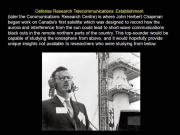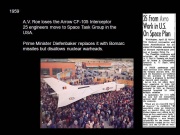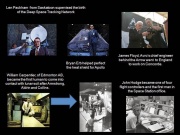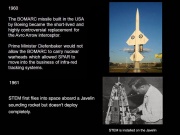100 Years of Aerospace History in Canada: From McCurdy to Hadfield Part 5 by Robert Godwin
From The Space Library
The Arrow: That Watershed Year when the Best Canadian Engineers moved to the US
1959 would prove to be a watershed year in Canada's aeronautical and astronautical research.
In January of that year work began at the Defense Research Telecommunications Establishment (DRTE) in Ottawa, under John Herbert Chapman, to devise a "top-sounding" satellite for Canada which was designed to record how the aurora and interference from the sun could lead to short-wave communications black-outs in the remote northern parts of the country. This satellite would be capable of bouncing radio waves off the ionosphere from above, and it would hopefully provide unique insights not available to researchers who were studying from below. Dr Eldon Warren of DRTE made the first suggestion that Canada attempt the audacious plan to build a multi-band spaceborne radar system.
At the beginning of October 1958 NASA officially came into existence in the United States; just a few days later a meeting took place at Cornell University in New York State in which Peter Forsyth of the University of Saskatchewan expressed his interest to the Americans in the benefits of a top-sounding satellite, in response to a call put out by the Space Science Board of the U.S. National Academy of Sciences.[i]
Also in February of that year the A.V. Roe Company, based in Malton, a suburb of Toronto, was dealt a devastating blow when the CF-105 Arrow interceptor program was cancelled.
At the end of World War II Sir Roy Dobson had borrowed $1000 to incorporate Avro Canada and had also persuaded C.D. Howe, the so-called "minister of everything", to lend him the enormous factory where so many Lancaster bombers had been built during the war. By 1957 Dobson’s companies in Canada employed 25,000 people and had assets of $120Mln CDN.
The company was managed by the dynamic and sometimes abrasive Crawford Gordon who had persuaded the politicians and the Canadian military that Avro was capable of building a world-beating interceptor to defend Canada against any potential threat from the Soviet Union. Just as the first aircraft began to trundle off the production line a new government, under Prime Minister John Diefenbaker, decided that Canada could not afford the extravagance of the Arrow and unceremoniously cancelled the program.
Dr Phil Lapp happened to be in the Prime Minister's office during one particularly inflammatory encounter between Gordon and Diefenbaker. A few weeks later, on 20th February 1959, Lapp listened in on the telephone as the cancellation announcement came in to Avro. This event became known as "Black Friday" because Gordon immediately announced the lay-off of approximately 13,000 employees.
The consequences of this moment have been discussed in great detail by many of the participants and also by Arrow scholars such as Chris Gainor[ii] and Randall Whitcomb.[iii]
The principle engineer at Avro, James C. Floyd, would soon leave Canada for England where he would be instrumental in the birth of the Concorde supersonic transport.
However, undoubtedly the most significant consequence was the immediate windfall for the newly formed NASA in the United States. Within hours of the lay-offs at Malton, Dr Robert Gilruth, head of the Space Task Group in Langley Virginia, landed at Toronto airport and immediately began recruiting the cream of the Avro engineering staff to assist in the recently announced United States' Man in Space program.
This "brain drain" would ultimately be one of the many factors taken into consideration years later when considering the need for a Canadian national space agency.
The most notable recruits to NASA from Avro were, James A. Chamberlin (he became Technical Assistant to Robert Gilruth), Owen E. Maynard and Rodney G. Rose (they went on to NASA's Systems Test Branch, Maynard to head up the lunar lander program), David D. Ewart (Aerodynamics Section), George E. Watts and James E. Farbridge (head and assistant of Loads Section), Eugene L. Duret and Richard B. Erb (Heat Transfer Section), Norman B. Farmer (Electrical Systems Section), Richard R. Carley, Thomas V. Chambers and Stanley Galezowski (Flight Controls Section), John D. Hodge (Assistant to the Division Chief of Operations), Jack Cohen (Mission Analysis Branch), Stanley Cohn and John Shoosmith (Mathematical Analysis Section), Frank J. Chalmers, Dennis E. Fielder, John K. Hughes, C. Frederick Matthews, Leonard E. Packham and Tecwyn Roberts (Control and Flight Safety Section), Bruce A. Aikenhead (Training Aids Section), and Peter J. Armitage (Recovery Operations Branch).[iv]
As can be seen from this list NASA's Space Task Group, which had been formed by Gilruth with only 36 people on October 5th 1958, inherited a ready-made team to assist the rapidly burgeoning program at Langley. The Canadians showed up for work at the Space Task Group on April 13th 1959, just three months after McDonnell had been issued the contract to build the Mercury spacecraft and more than a year before the von Braun team would move over from the US Army to NASA. For more than twelve months there were more Canadians than Germans at NASA!
Many theories have been postulated for why the Canadian government decided to cancel the CF-105 program, but even Kurt Stehling, who had already moved over to the US space program had spoken out a few months earlier against the expensive interceptor.[v] Stehling later admitted that he had chosen to move to the United States because of his frustration with the way funding was limited in Canada.
Other engineers such as Wilfred Dukes had left Avro even earlier than the Arrow cancellation; lured by the seemingly unlimited funds south of the border. Dukes would write one of the first papers in the United States on hypersonic re-entry[vi] and would join Walter Dornberger's team with Stehling at Bell Aircraft in Buffalo in the early 1950s. Duke's knowledge would be integrated into Bell's BoMi, a proposed winged space bomber under discussion at that time. Although Bell would not get the contract (Boeing won the bid and named it the X-20), Duke's know-how would be sought for many years and he would be on the commission to investigate the delays in the Space Shuttle program decades later.[vii]
Meanwhile, Stehling co-authored a patent at Bell, with famed rocket backpack pioneer Wendell Moore, for the reaction control system which later appeared on the X-15 and would ultimately evolve into the system on the Space Shuttle.
But in 1958 the prevailing attitude was that missiles would replace aircraft interceptors. The United States' President Eisenhower had convinced Prime Minister Diefenbaker to purchase the experimental US-made Bomarc missile, but having agreed to the purchase, Diefenbaker refused to allow the missile to be equipped with nuclear warheads.
This led to a further opportunity for DeHavilland's Special Projects Division, again led by Phil Lapp, to sell their expertise in infra-red tracking and fuses for the Bomarc. However, when Lester Pearson became Prime Minister in 1963 the nuclear warheads were allowed and DeHavilland was suddenly out of a contract again, since nuclear warheads didn't need infra-red capabilities.[viii]
Footnotes
[i] The Alouette Satellite Program - Colin A. Franklin, Chief Electrical Engineer, Alouette I program
[ii] Arrows to the Moon, Apogee Books 2001
[iii] Cold War Tech War, Apogee Books 2008
[iv] Memorandum for Staff, Space Task Group, August 10 1959
[v] Globe and Mail Oct 22 1958
[vi] Structural Design for Aerodynamic Heating, W. Dukes and A. Schnitt Bell Aircraft WADC Technical Report 55-305
[vii] Robert Godwin taped interview with Wilfred Dukes, 2003
[viii] Phil Lapp Memoir pg 130




